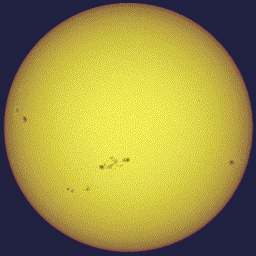|
THE SUN'S ROTATION
|
||||||||||||||||||||||||||||||||||
|
History and future of the
Naturally occurring energy is all around us. The problem is in collecting it. Plants do it with leaves on land using chlorophyll to convert the Sun's rays into energy to grow. Algae does it in the sea. There is energy in the wind and in the waves, derived from the Sun. Energy from the Sun reaches us across space as radiation. Radiation is one of the most efficient ways of transmitting energy - lucky for us. The radiation heats the Earth's surface which in turn creates wind and waves as the earth tries to cool itself by convection currents. All this means is that heated air or water tries to flow to cooler parts of the Earth at the poles. Simple really, but the land masses and water evaporation all go to disturb any regular flow, and this is how weather systems develop to be unpredictable.
The Earth collects around 1 kilowatt of energy per square meter from the Sun's radiation. We can collect this radiation (called insolation) using photovoltaic cells, or solar cells. If we connect a number of these cells together we can harness quite a bit of electricity, even if solar cells at this time are only 10-15% efficient. As you can see from the picture above Solar Navigator has a large area of solar panels arranged to face the Sun. The crew must keep away from these panels to prevent shading.
Solarnavigator also collects the Sun's energy from the wind. As you can see in the picture below, Solar Navigator also generates electricity from the wind which the crew can use to cook food and power navigation equipment. This is why the vessel is known as a hybrid: there is more than one natural energy source being collected. Four wind turbines are being tested on this 1/20 model of the wave piercing catamaran.
LINKS:
TECHNICAL DESCRIPTION | SOLAR WINGS | CONTROL ELECTRONICS | ROBOT DESIGNER
COMPONENTS:
Light
sensor: LDR Sensor
processor: microchip PIC comparator Maths
processor: microchip PIC Serial
port override: handheld device or laptop Actuator
drive: independently controlled by microchip PIC Actuator
feedback sensor: processed by microchip PIC
The ultimate Robot Boat. Solarnavigator uses an advanced SWASSH hull as the platform to mount the world's first autonomous circumnavigation. A successful expedition could pave the way for improved safety at sea.
|
||||||||||||||||||||||||||||||||||
|
This website is copyright © 1991- 2013 Electrick Publications. All rights reserved. The bird logo and names Solar Navigator and Blueplanet Ecostar are trademarks ™. The Blueplanet vehicle configuration is registered ®. All other trademarks hereby acknowledged and please note that this project should not be confused with the Australian: 'World Solar Challenge'™which is a superb road vehicle endurance race from Darwin to Adelaide. Max Energy Limited is an educational charity working hard to promote world peace. |
||||||||||||||||||||||||||||||||||
|
AUTOMOTIVE | BLUEPLANET BE3 | ELECTRIC CARS | ELECTRIC CYCLES | SOLAR CARS | SOLARNAVIGATOR |
||||||||||||||||||||||||||||||||||

